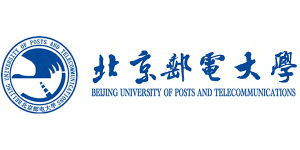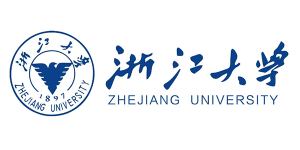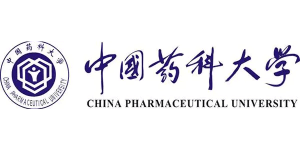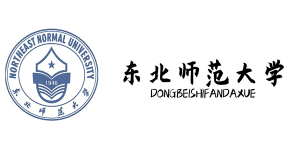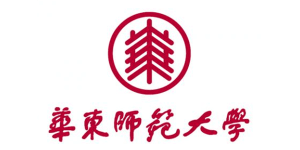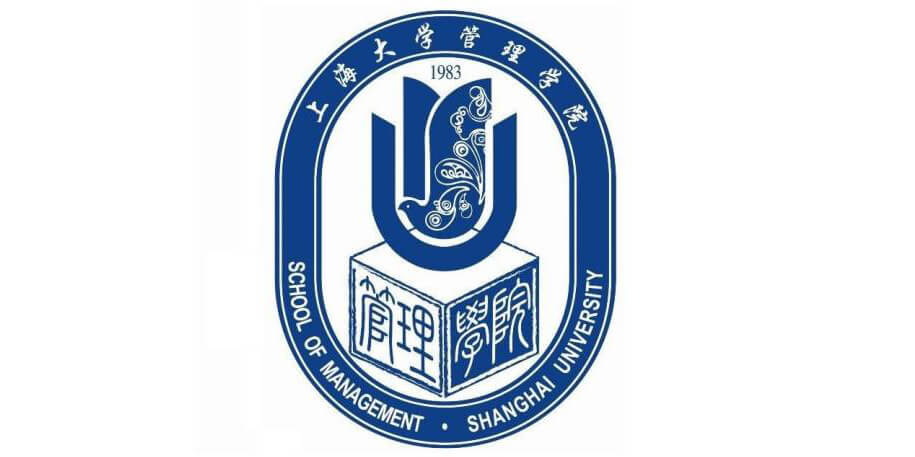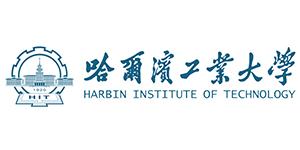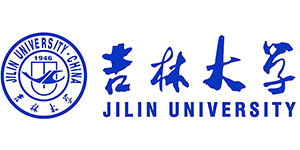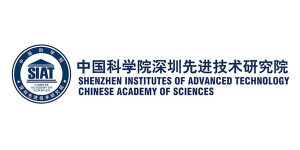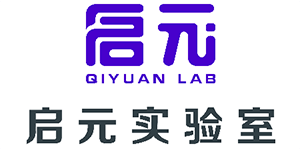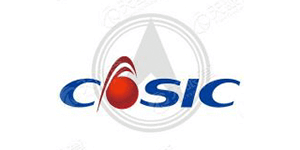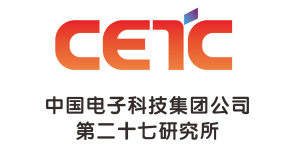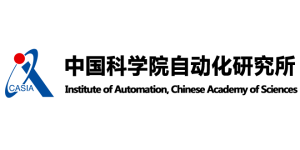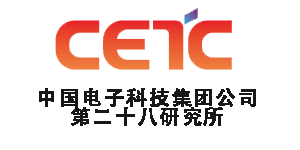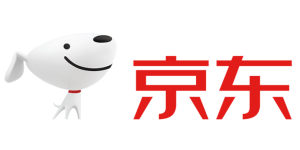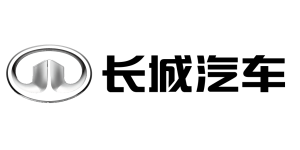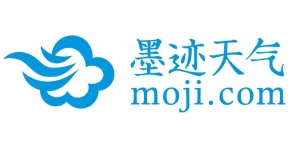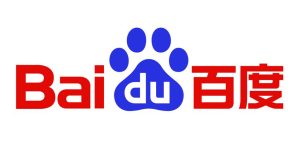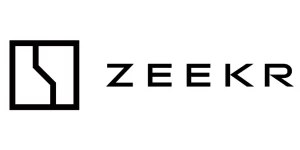This article was co-authored with me by Mengjie Zhang, a master's student I supervised in the class of 2020. She is the first student I brought with me. Through the communication with Mengjie since her admission, I found her to be a beautiful girl with high sensitivity and strong interest in scientific research, who can quietly and deeply study scientific problems. As soon as she enrolled, she got involved in my research work and carried out research at the grassroots level. With such persistent efforts, Mengjie has achieved good results and completed three high-quality papers, two of which have been published in the Journal of Ecology and Behavioral Science.
Mengjie is graduating this summer, and I think she has the space and potential to continue to improve. Although there is a lot of reluctance, I hope my student, will be given better opportunities to continue her studies and that she will continue to maintain her love for research and passion for learning in the future!
Hou Caixia
Neural Engineering Management Laboratory, Xi'an University of Architecture and Technology
This is the first time that "Neuroengineering Management135Essay Introduction
Content source: Mengjie Zhang (Master's degree student, Class of 2020)
This issueEditor: Gou Lingjiang ((Class of 2022 Master's degree students)
Proofreader: Xiaotong Guo
Reviewed by: Fu Hanliang
For academic purposes only, the original text is copyrighted by the original author and the original publication
This paper is a response to the question "The impact of user reviews on public willingness to consume recycled water from a consumer perspectivemechanism of user comments on public's consumption intention of recycled water - Evidence from eye tracking experiments (Influence mechanism of user comments on public's consumption intention of recycled water from the perspective of consumers: Evidence from eye tracking experiments)," an interpretation of a paper published in 2023 in the Journal of Ecology. The authors of the study are Caixia Hou, Mengjie Zhang*, Xueyan Zhao, and Hanliang Fu.
Paper DOI: 10.5846 / stxb202205071261
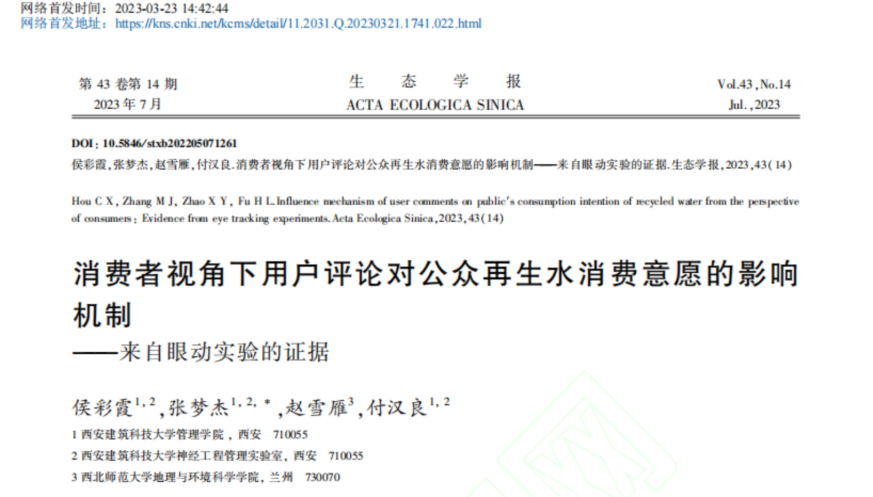

Reclaimed water reuse is an effective way to solve water scarcity, which is of great significance to alleviate regional water scarcity and promote environmental protection. As a direct user of recycled water, the public's attitude toward recycled water is a key aspect of the implementation of recycled water reuse projects. As a recycled water product, the price is the monetary cost that consumers must pay to use recycled water, and user reviews are the most direct way for consumers to understand recycled water and assess its quality. In order to more clearly identify the influence mechanism of price and user reviews on the public's willingness to use recycled water, this study takes a consumer perspective, simulates a recycled water purchase scenario, and uses the stimulus-organism-response model as the theoretical framework, using a 3 (experimental grouping: high price, medium price and low price) × 2 (review classification: quality review and environmental comments) eye-tracking experiments to explore the behavioral mechanisms in the public's recycled water purchase decision process and further analyze the differences in the public's recycled water use behavior under different prices. The results of the study indicate that:(1) Public willingness to use recycled water was highest in the medium price group, followed by the low price group, and lowest in the high price group. (2) The public decision-making process is biased to pay attention to the negative comment content, whether it is reclaimed water quality evaluation or environmental evaluation. In the low price group, the public is most concerned about the content of comments, the high price group is the lowest, and in the medium price group, the public is more concerned about the impact of recycled water on the environment. (3) In the consumption process, the public's concern about the content of comments affects the consumption emotion and thus the willingness to use recycled water. (4) The price of recycled water plays an important moderating role in the public's consumption decision process. In the low price group, comment content influences the public's willingness to use recycled water through arousal, in the medium price group, comment content influences the public's willingness to use recycled water through pleasure, and in the high price group, none of the influence paths are significant. This study can provide scientific reference for further promotion of reclaimed water and optimal allocation of water resources.
China is one of the countries with the most serious water shortage in the world, with extremely uneven distribution of water resources in time and space, and a continuous deterioration of the water environment as a whole, which seriously threatens the sustainable development of social and economic development and people's lives. To solve the problem of water shortage, water environment pollution, water ecological damage, in January 2021, the National Development and Reform Commission and other departments jointly issued the "Guidance on Promoting the Resourceful Use of Wastewater" pointed out that "in the urban, industrial and agricultural and rural areas and other areas of the system to carry out the resourceful use of sewage". With the rapid development of science and technology, sewage treatment technology has been developed to produce almost any water quality standards to meet the reclaimed water, however, as of 2019, China's urban reclaimed water use only accounts for 20% of the amount of sewage treatment, the use of reclaimed water is also limited to the pathway for road washing, landscape water, etc.. Why has long broken through the technical difficulties of recycled water reuse is difficult to transform into real productivity, the first is the public's willingness to use. Reclaimed water as a renewable resource products, the promotion of its use can not be separated from the consumer. The price is the monetary cost that consumers must pay to use recycled water, which is an important clue for consumers to assess the value of recycled water and influence the market demand for recycled water. Currently, reclaimed water is not fully popular and consumers have limited access to reclaimed water information. User reviews have become the most direct way for consumers to understand reclaimed water and assess its quality. Therefore, this study takes consumers as the perspective, simulates the online purchase scenario of reclaimed water, adopts the eye-tracking experiment method, and analyzes the public's cognitive processing of different reviews based on the clarification of the public's willingness to use reclaimed water at different prices, and uses the Stimulus-Organism-Response (S-O-R) model as the theoretical framework. To explore the influence mechanism of user comments on recycled water reuse behavior, and further analyze the difference of public recycled water use behavior under different prices, so as to provide scientific reference for further promotion of recycled water and optimal allocation of water resources.
2.1 User Comments
User reviews are mainly reviews about products or merchants published by consumers after they have purchased or used the products. Studies have shown that the influence of reviews is affected by review characteristics, such as review content, quantity, length, and validity. The information revealed by the review content affects the public's cognitive behavior, and the negative effects triggered by negative reviews are more significant than the positive effects of positive reviews. In addition, the influence of online reviews is also influenced by the type of product, and consumers pay more attention to user reviews for products for which it is difficult to obtain information about product quality.
Studies have found that the public is reluctant to use reclaimed water due to its water quality and potential health risks, and is even less willing to purchase agricultural products irrigated with reclaimed water. Other scholars have argued that the public's perceived behavioral characteristics also have a significant impact on the willingness to use reclaimed water. The higher the public's perceived environmental value of reclaimed water, the stronger the willingness to use it. Those individuals who are more aware of environmental protection and worried about the future water supply situation also have more positive attitudes toward recycled water and even express willingness to accept recycled water as drinking water. It can be seen that recycled water quality and environmental value are important variables that cannot be ignored in analyzing the public's willingness to use. Therefore, in this study, relevant user evaluations characterizing the quality of reclaimed water and the environmental impact of reclaimed water were chosen as stimulus variables.
2.2 S-O-R model
Mehrabian and Russell proposed the Stimulus-Organism-Response (S-O-R) model based on environmental psychology, which suggests that stimuli in the environment affect people's emotional state, which in turn affects their behavior. Donovan and Rossiter first applied the S-O-R model to the retail environment. With the development of the Internet, the S-O-R theoretical model has been widely used to study the behavior of consumers in online shopping. In the retail environment, the stimulus (S) represents various situational factors, such as product price, product features, promotions, brand reputation, online reviews, etc., the mediating variable organism (O) represents changes in emotions, and the outcome variable response (R) represents tendency or avoidance behaviors. The tendency behavior indicates willingness to shop, willingness to browse, increase in dwell time, etc., while the avoidance behavior is the opposite of the above behaviors.
Reclaimed water purchase decision process, consumers are exposed to user reviews, cognitive processing of the review content, which in turn triggers a series of psychological activities. The willingness to purchase recycled water is an important reflection of the behavioral results of the cognitive processing of the review content. Therefore, this study selects consumers' gaze time on the review content as the stimulus variable S, consumer emotion as the organism variable O, and recycled water purchase intention as the outcome variable R. By simulating an actual recycled water purchase scenario, the S-O-R model (Figure 1) is established to reveal the behavioral mechanism in the public's recycled water purchase decision process and further explore the behavioral differences of the public under different prices.
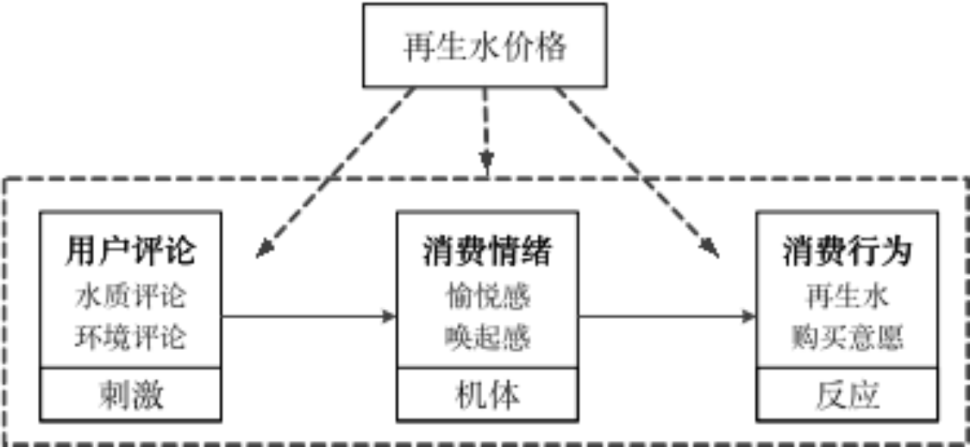


Figure 1 Stimulus-organism-response study model
To investigate the public's cognitive processing of recycled water user reviews and to clarify the differences in the public's recycled water purchasing behavior at different prices. In this study, a mixed experimental design of 3 (experimental grouping: high price vs. medium price vs. low price)*2 (review classification: quality review vs. environmental review) was used, where price was the grouping variable and experimental participants were randomly assigned to one of the experimental groups. With reference to the tap water price in Xi'an and the ratio between recycled water and tap water price in Beijing and Tianjin, RMB 0.8/m3 was selected as the low price group, RMB 1.6/m3 as the medium price group, and RMB 2.8/m3 as the high price group. Experimental participants were required to browse the reclaimed water shopping details interface and make shopping decisions in a specific experimental context. The eye-movement data, behavioral data and questionnaire data of the experimental participants were collected simultaneously in the experiment.
3.1 Research Methodology
3.1.1 Eye tracking technology
Vision is the main channel for humans to obtain external information, and cognitive psychology believes that visual attention can reflect the cognitive processes of the brain, and human mental activities can be explored through the eyes. Eye tracking technology can capture and record the eye movement trajectories of experimental participants, which is an effective method to reveal the cognitive process of consumers and predict their behavioral decisions. Gaze duration is an important eye-movement indicator to characterize consumers' cognitive process, which is widely used in consumer behavior research. The average gaze duration is the average of the duration of all gaze points in the area of interest. In this study, the average gaze duration in the interest area was selected as an oculomotor indicator to measure the cognitive processing of consumers, and further analyzed the level of consumer interest in different evaluation contents. In addition, by overlaying all participants' gaze points on the same stimulus material will result in a heat zone map, which can reflect the most interesting areas in the public's reclaimed water purchase decision process.
3.1.2 Measurement of emotions
In their study of the effects of environmental stimuli on consumers' behavioral responses in shopping malls, Mehrabian and Russell proposed the PAD model, which divides consumer emotions into three dimensions: Pleasure, Arousal, and Control. In 1980, Russell proposed a two-dimensional model of consumer emotion, i.e., emotion is a continuum consisting of two pairs of opposites: pleasurable-unpleasant and arousal-calm, with pleasure referring to the consumer's positive feelings toward the stimulus, i.e., feelings of pleasure, anticipation, and satisfaction, and arousal manifesting as the individual's The sense of arousal is expressed as the state of being activated after receiving an environmental stimulus, e.g., excitement, agitation, and frenzy [36]. In the study of consumer behavior, the dimensions of arousal and pleasure are crucial. Therefore, this study used the pleasure and arousal dimensions of the PAD scale to measure changes in the public's emotions during the reclaimed water purchase decision process.
3.2 Stimulus material design
In order to better observe and record the behavior of the participants in the process of purchasing recycled water, this experiment designed stimulus materials according to the Taobao product details page in order to enhance the immersion and experience of the participants. The experiment ensured that the participants had sufficient time to browse through the interface information of each recycled water product. Considering that negative user comments have a greater impact on consumer decision making behavior, three positive user comments and two negative user comments were used in this study. Considering that the gaze duration may also be caused by the subjects' difficulty in understanding the stimulus images, this study screened the review contents, selected the review information with concise and clear language expressions, and set the review areas into four interest zones according to the polarity of the reviews (Figure 2). The top left area is the positive feedback on reclaimed water quality (AOI001), the bottom left area is the poor feedback on reclaimed water quality (AOI002), the top right area is the positive feedback on reclaimed water environment (AOI003), and the bottom right area is the poor feedback on reclaimed water environment (AOI004), and all comments have similar word counts.
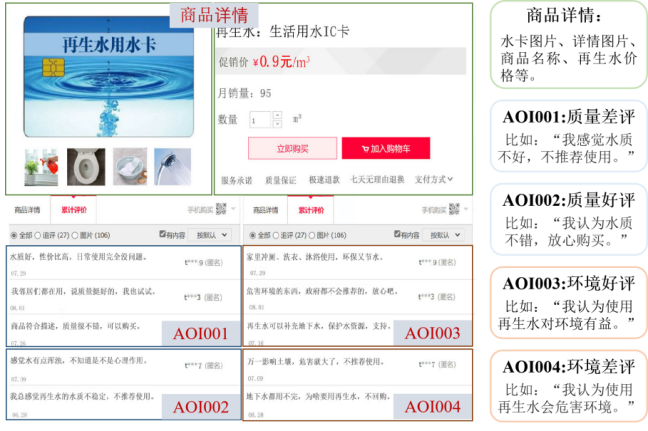


Figure 2 Stimulus material
3.3 Subjects and experimental procedure
The eye-tracking device used in this experiment wasThe Tobii Pro Fusion eye-tracking device with a sampling rate of 250 Hz and an eye-tracking server built into the eye-tracking device to capture video images of the eyes of the experiment participants. In this study, 118 healthy students from Xi'an University of Architecture and Technology were selected to participate in the eye movement experiment. Among them, 12 participated in the pre-experiment and 7 were excluded from the formal experiment due to low eye-movement data collection rate, and data from a total of 99 experimental participants (56 males and 43 females) were used. A total of 32 participants were in the low-price group, 34 in the medium-price group, and 33 in the high-price group. All experimental participants had normal visual acuity or corrected visual acuity.
The experiment was completed in the neuroengineering management laboratory of Xi'an University of Architecture and Technology, with good indoor air quality and appropriate light and temperature. Before the experiment started, the subjects were informed of the precautions and operation methods, and the oculomotor was adjusted to calibrate the subjects' eyes. After the experiment starts, the experimental instruction is presented on the screen: "Assuming that your community has completed the renovation of reclaimed water pipeline, you only need to recharge the water card on Taobao (the card is free) to use reclaimed water, while the tap water can also be used normally (the tap water price is 3.8 RMB/m3)", so that the subjects enter the specific experimental situation. The next screen will present the recharge interface of the recycled water card, and the experiment participants will have plenty of time to browse. After each recharge interface is presented, the subject presses the "space bar" and enters the rating interface. The subject has to rate the willingness to use recycled water from 1 (very reluctant to buy) to 7 (very willing to buy) and respond with the corresponding keys. After all pages were viewed, the experiment was completed. Subjects were required to report their emotions and perceptions during the shopping process and fill out the questionnaire. The specific experimental procedure is shown in Figure 3.
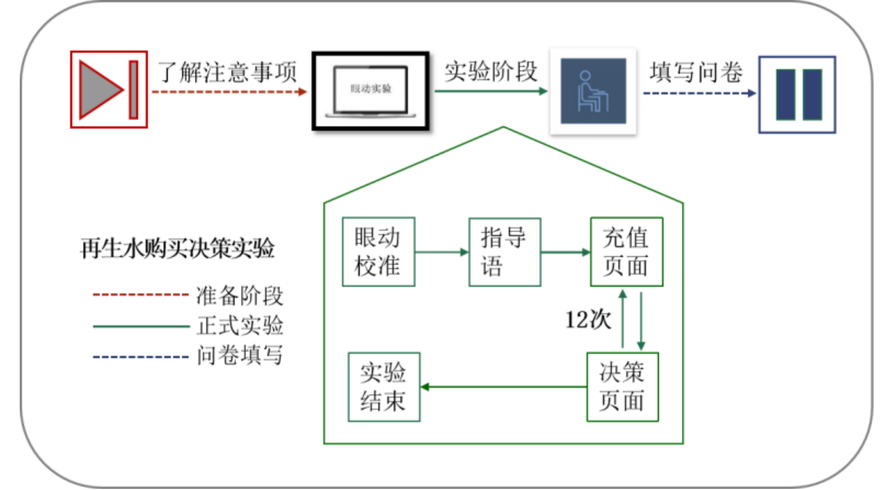


Figure 3 Experimental flow
4.1 Public willingness to use recycled water at different price levels
In this study, a paired-samples t-test was conducted on the public's willingness to purchase in different price groups (Figure 4). The results found that there was a significant difference in the mean (M) of the public's willingness to purchase recycled water in the medium-low and medium-high price groups. The public's willingness to use recycled water was highest in the medium price group (M=4.99, SD=0.901), followed by the low price group (M=4.42, SD=1.041), and lowest in the high price group (M=4.36, SD=1.127). When the price of reclaimed water is significantly lower, the public may be attracted by the price and feel highly excited, which may lead consumers to purchase behavior. However, too low a price may cause consumers to question the quality of recycled water. When the price of recycled water is higher than consumers' psychological expectations, the public may choose to use tap water, and the willingness to use recycled water will be significantly reduced.
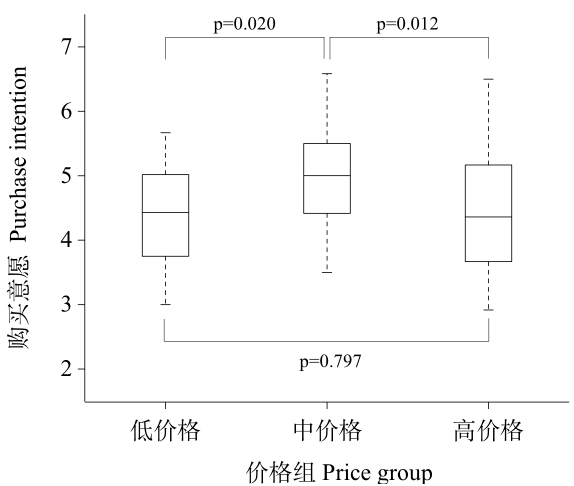


Figure 4 Paired t-test of the public's willingness to purchase recycled water: comparison of different price groups
4.2 Analysis of the differences in the public's information concerns about reclaimed water
This study used a heat zone map to visualize the participants' gaze information (Figure 5). According to the heat zone diagram, participants commented on the price of reclaimed water in the darkest color and for a longer period of time, which shows that price is an important factor influencing whether the public uses reclaimed water or not. Comparing the heat zone diagrams of the high, medium and low price groups, it can be seen that in the low price group, the length of time participants gazed at the content of comments was significantly greater than in the medium and high price groups; in the medium price group, participants gazed at the environmental benefits of reclaimed water to a significantly greater extent and in a darker color compared to the evaluation of water quality type; in the high price group, participants gazed at the content of comments for the least amount of time and in the lightest color .
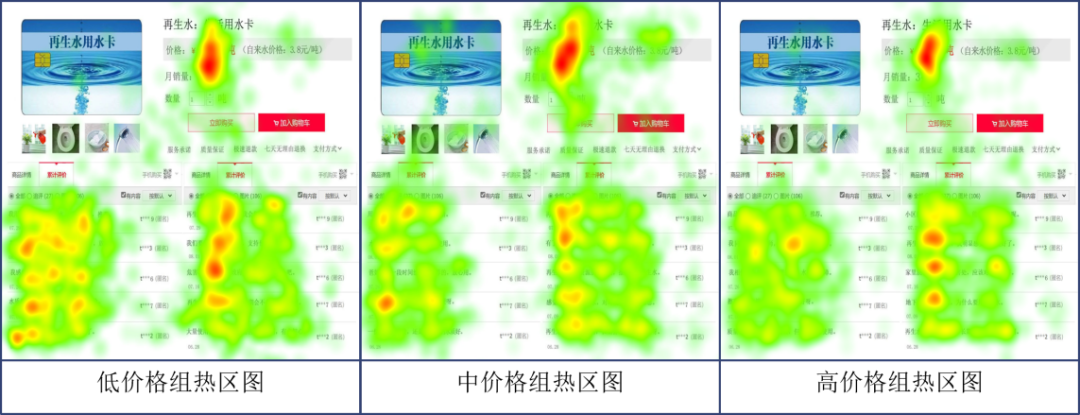

Figure 5 Eye movement heat map of the public's willingness to purchase recycled water
Note: where the red area indicates that the most attention was received, yellow, green, blue in that order, no color indicates that no attention was received.
To further compare the importance and interest of consumers in the purchase decision process for different types of reviews, this study conducted a paired-samples t-test on the average gaze duration for different interest areas at the same price (Figure 6). In the low price group, for the same type of reviews, the gaze duration of good quality reviews versus poor quality reviews and good environmental reviews versus poor environmental reviews were all significantly different at the significance level of P<0.001, which indicates that the public pays more attention to the content of others' poor reviews than positive reviews in the public water reclamation decision process. In the same validity comments, the length of attention of the two groups of poor quality comments and poor environmental comments is significant at the significance level of P<0.05, which indicates that the public is more concerned about the poor water quality comments than the poor environmental comments. In the medium-price group, for the same type of reviews, the length of attention of good quality reviews and poor quality reviews, good environmental reviews and poor environmental reviews are significantly different at the significance level of P<0.01. For the same type of validity reviews, there were no statistically significant differences between good quality reviews and good environmental reviews, or between poor quality reviews and poor environmental reviews. The results were similar in the high-price group. Behavioral science and psychology suggest that people typically value negative information more than positive information, which is also consistent with the findings of this paper. The public holds negative implicit attitudes toward reclaimed water. On the one hand, due to the negative attitude toward reclaimed water, the public may pay more attention to the content of poor reviews of reclaimed water during the consumption process to corroborate their opinions. In addition, from the consumer's perspective, the public assesses the health risks of reclaimed water and its impact on the environment during the reclaimed water purchase process in order to avoid risks. As a result, consumers may pay more attention to negative reviews and process the negative reviews to a greater degree of awareness.
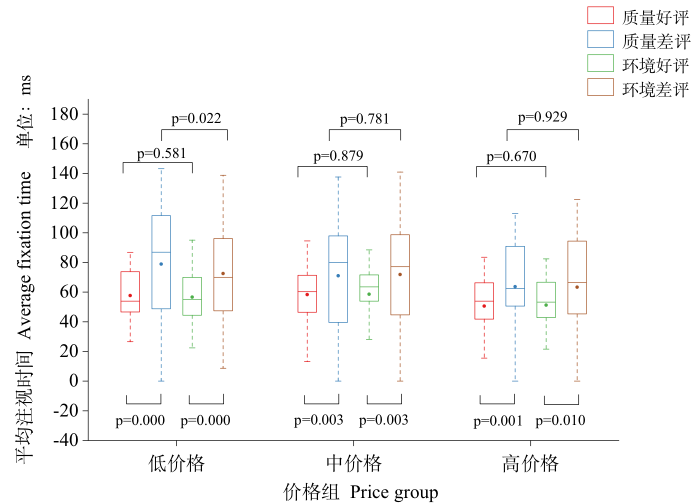

Figure 6 Paired t-test for mean gaze time in the area of interest: comparison of differences at the same price
4.3 Impact of information concerns on public willingness to use recycled water
After completing the tests of model reliability and validity, in order to analyze the intrinsic relationship between public information attention and willingness to use recycled water, the S-O-R model was constructed in this study, and Partial Least Squares (PLS) based on variance was chosen as the modeling method, and the samples were analyzed using Smart PLS 3.0 software. The results of the structural equation are shown in Figure 7. At the level of stimulus S on organism O, public attention to recycled water review content negatively affects consumers' pleasure and arousal, with path coefficients of -0.178 and -0.265, respectively. The more attention is paid to the content of recycled water comments, the weaker the pleasure and excitement, and the lower the willingness to use recycled water. Since the public holds a negative attitude toward reclaimed water, it is difficult to stimulate a sense of anticipation in the purchase decision process, even if they see information about reclaimed water products. On the other hand, reclaimed water is an unfamiliar and new commodity, and the public may have less knowledge about reclaimed water. In order to assess the quality of reclaimed water, the public may rely more on the evaluation of others, and because the public is more inclined to gaze at negative comments, the cognitive processing of negative comments is higher, and even, individuals will expand their perception of the risk of things for their own safety, which may lead to a negative effect of concern about the content of the comments on The public's consumer sentiment, so that the public satisfaction with reclaimed water, the sense of expectation is lower, the degree of consumer arousal is also lower.
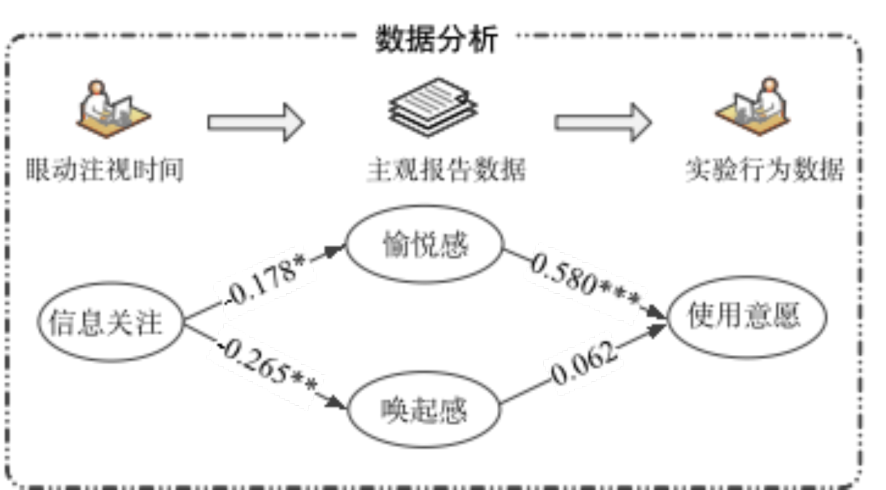

Figure 7 Structural equation model of the public's willingness to use recycled water
Note: * indicates significant at 0.05 level of correlation; ** indicates significant at 0.01 level of correlation; *** indicates significant at 0.001 level of correlation.
To analyze the mechanism of price influence on the public's willingness to use recycled water, this study examined the relationship between potential variables in different price groups using price as the grouping variable with 5000 iterations). The results of the multi-cluster structural equation (Table 1) show that in the low price group, public attention to the content of recycled water reviews negatively affects arousal, with a path coefficient of -0.318, and arousal significantly affects public willingness to use recycled water, with a path coefficient of 0.447. This indicates that the more attention consumers pay to user reviews, the weaker the arousal of emotions, i.e., the less arousal consumers feel when they see information about recycled water products , and the lower the willingness to use reclaimed water. In the medium price group, concern about the content of recycled water reviews significantly affects the public's sense of pleasure about recycled water, with a path coefficient of -0.343, and pleasure positively affects the public's willingness to use, with a path coefficient of 0.354. This indicates that concern about the content of reviews reduces the public's sense of pleasure, i.e., the more concerned consumers are about the content of reviews, the lower the sense of expectation and satisfaction about recycled water, resulting in the public's reluctance to to use reclaimed water. In the high price group, information concerns did not cause changes in consumer pleasure and arousal. This may be due to the fact that when the price of reclaimed water is closer to that of tap water, the public, on balance, is more willing to use tap water, and therefore, consumers are less influenced by user comments.
Table 1 The path of influence of user comments on public willingness to use recycled water


Note: * indicates significant at 0.05 level of correlation; ** indicates significant at 0.01 level of correlation; *** indicates significant at 0.001 level of correlation.
The study of recycled water reuse involves regional water resources security and ecological environmental protection, which is of great significance to regional ecological security and sustainable development, and the study of public willingness to reuse recycled water and its influencing factors can provide scientific guidance for the study of regional ecological security. In this study, by simulating a real recycled water purchase scenario and designing an eye-tracking experiment of public recycled water purchase behavior, we explore the influencing factors and behavioral mechanisms in the public recycled water purchase decision process and obtain the following main conclusions:
(1) Public willingness to use recycled water is highest in the medium price group, second highest in the low price group, and lowest in the high price;
(2) In the reclaimed water purchase decision process, the public is biased to pay attention to negative comments, whether it is reclaimed water quality comments or environmental comments. In the low price group, the public pays the highest attention to the content of comments when deciding whether to use reclaimed water, in the medium price group, the public is more concerned about the environmental impact of reclaimed water when making decisions, and in the high price group, the public pays the lowest attention to user comments;
(3) Public attention to user comments changes the public's willingness to use recycled water by affecting the sense of pleasure, and the price of recycled water significantly moderates the relationship between user comments and the public's willingness to use recycled water.


Mengjie Zhang, Master's degree student of Xi'an University of Architecture and Technology, Class of 2020, supervised by Xiaojun Liu & Caixia Hou, emailzmj@xauat.edu.cn
He has published one paper in Behavioral Science (SSCI) and one paper in Journal of Ecology (sponsored by Chinese Society of Ecology, CSCD core) as the first author and corresponding author (one student work) respectively.
Hou Caixia.Zhang Mengjie,Zhao Xueyan,Fu Hanliang.The mechanism of user comments on public willingness to consume recycled water from a consumer perspective--Evidence from eye-movement experiments.Journal of Ecology,2023,43(14)
Hou C X, Zhang M J, Zhao X Y, Fu H L. Influence mechanism of user comments on public's consumption intention of recycled water from the perspective of consumers: Evidence from eye tracking experiments.Acta Ecologica Sinica,2023,43(14)



This article comes from the WeChat public number: EVERLOYAL







